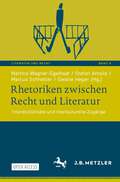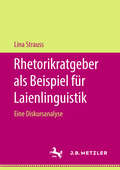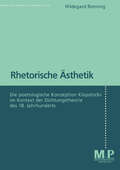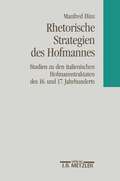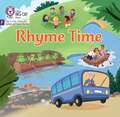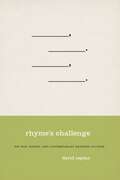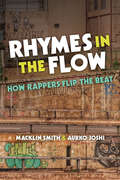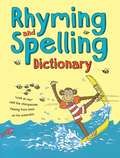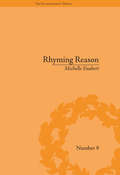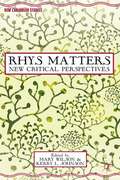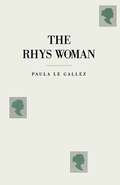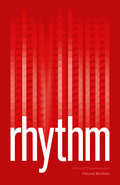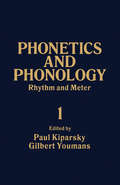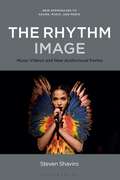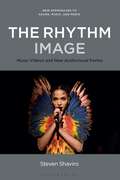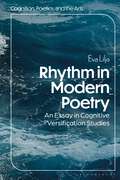- Table View
- List View
Rhetorik und Wissenspoetik: Studien zu Texten von Athanasius Kircher bis Miljenko Jergovic (Lettre)
by Renate LachmannEinige literaturwissenschaftliche Begriffe und Konzepte haben ihre Kontur erst allmählich im Laufe von Austauschbewegungen zwischen Ost und West gewonnen. Renate Lachmann kommentiert die Terminologien und analysiert literarische Texte sowie eine Auswahl an Modi der Wissensdarstellung (Kircher, Comenius). Sie greift dabei nicht nur auf neorhetorische Begriffe (Verfremdung, Intertextualität), sondern auch auf Begriffe der klassischen Rhetorik (Memoria, Evidentia, Affekt) zurück. Damit gelingt ihr die Beschreibung von Übersetzungs- und Aneignungsverfahren (der russische Heine, Nabokovs Puskin), der ›verborgenen‹ Aspekte der Texte Gogols und der affektgesteuerten Texte Dostojewskis.
Rhetoriken zwischen Recht und Literatur: Interdisziplinäre und interkulturelle Zugänge (Literatur und Recht #9)
by Martina Wagner-Egelhaaf Stefan Arnold Marcus Schnetter Gesine HegerDie Beiträge dieses Open-Access-Buchs diskutieren das Verständnis von Rhetorik, mit dem heute in Literatur- und Rechtswissenschaft gearbeitet wird. Sie beleuchten, inwiefern sich die westliche Tradition von rhetorischen Perspektiven aus anderen Sprach-, Kultur- und Rechtsräumen unterscheidet. Während die Rhetorik in antiker Tradition in der Literaturtheorie nach wie vor eine große Rolle spielt, hat sie ihren Status als Leitdisziplin in den Rechtswissenschaften eingebüßt und ist lediglich für Teilbereiche wie Argumentationstheorie und Rechtslogik relevant. Der Band nimmt Recht und Literatur in ihrer gemeinsamen sprachlichen Konstitution ernst und fragt nicht zuletzt nach einem geteilten Grundverständnis von Rhetorik.
Rhetorikratgeber als Beispiel für Laienlinguistik: Eine Diskursanalyse
by Lina StraussDie Studie setzt an der Schnittstelle von wissenschaftlicher Sprachkritik und naturwüchsiger Sprachbewertung an und versucht das historisch schwierige Verhältnis zwischen Laienlinguistik und Linguistik zu regulieren. Die zentrale These, dass viele der Schwierigkeiten im Kern auf eine falsche wechselseitige Wahrnehmung zurückführbar sind, wird gestützt, indem eine linguistische Diskursanalyse von 47 Rhetorikratgebern den Untersuchungsgegenstand "Laienlinguistik" schärft. So werden der Linguistik Alternativen in der Konzeptualisierung, aber auch im praktischen Umgang mit der ungeliebten Konkurrentin aufgezeigt. Damit betritt die Autorin perspektivisch sowie methodisch Neuland im Bereich der angewandten Linguistik.
Rhetorische Ästhetik: Die poetologische Konzeption Klopstocks im Kontext der Dichtungstheorie des 18. Jahrhunderts
by Hildegard BenningRhetorische Strategien des Hofmanns: Studien zu den italienischen Hofmannstraktaten des 16. und 17. Jahrhunderts. Romanistische Abhandlungen, Band 6
by Manfred HinzRhyme's Challenge: Hip Hop, Poetry, and Contemporary Rhyming Culture
by David CaplanRhyme's Challenge offers a concise, pithy primer to hip-hop poetics while presenting a spirited defense of rhyme in contemporary American poetry. David Caplan's stylish study examines hip-hop's central but supposedly outmoded verbal technique: rhyme. At a time when print-based poets generally dismiss formal rhyme as old-fashioned and bookish, hip-hop artists deftly deploy it as a way to capture the contemporary moment. Rhyme accommodates and colorfully chronicles the most conspicuous conditions and symbols of contemporary society: its products, technologies, and personalities. Ranging from Shakespeare and Wordsworth to Eminem and Jay-Z, David Caplan's study demonstrates the continuing relevance of rhyme to poetry -- and everyday life.
Rhyme's Challenge: Hip Hop, Poetry, and Contemporary Rhyming Culture
by David CaplanRhyme's Challenge offers a concise, pithy primer to hip-hop poetics while presenting a spirited defense of rhyme in contemporary American poetry. David Caplan's stylish study examines hip-hop's central but supposedly outmoded verbal technique: rhyme. At a time when print-based poets generally dismiss formal rhyme as old-fashioned and bookish, hip-hop artists deftly deploy it as a way to capture the contemporary moment. Rhyme accommodates and colorfully chronicles the most conspicuous conditions and symbols of contemporary society: its products, technologies, and personalities. Ranging from Shakespeare and Wordsworth to Eminem and Jay-Z, David Caplan's study demonstrates the continuing relevance of rhyme to poetry -- and everyday life.
Rhymes in the Flow: How Rappers Flip the Beat
by Macklin Smith Aurko JoshiDespite its global popularity, rap has received little scholarly attention in terms of its poetic features. Rhymes in the Flow systematically analyzes the poetics (rap beats, rhythms, rhymes, verse and song structures) of many notable rap songs to provide new insights on rap artistry and performance. Defining and describing the features of what rappers commonly call flow, the authors establish a theory of the rap line as they trace rap’s deepest roots and stylistic evolution—from Anglo-Saxon poetry to Lil Wayne—and contextualize its complex poetics. Rhymes in the Flow helps explain rap’s wide appeal by focusing primarily on its rhythmic and thematic power, while also claiming its historical, cultural, musical, and poetic importance.
Rhyming and Spelling Dictionary
by Pie Corbett Ruth ThomsonThe book supports both the writing and spelling objectives of theNational Literacy Strategy at KS2 and should appeal to parents keen tohelp their children extend their vocabulary and develop their writingskills.
Rhyming and Spelling Dictionary
by Pie Corbett Ruth ThomsonThe book supports both the writing and spelling objectives of the National Literacy Strategy at KS2 and should appeal to parents keen to help their children extend their vocabulary and develop their writing skills.
Rhyming Reason: The Poetry of Romantic-Era Psychologists (The Enlightenment World)
by Michelle FaubertDuring the Romantic era, psychology and literature enjoyed a fluid relationship. Faubert focuses on psychologist-poets who grew out of the literary-medical culture of the Scottish Enlightenment. They used poetry as an accessible form to communicate emerging psychological, cultural and moral ideas.
Rhyming Reason: The Poetry of Romantic-Era Psychologists (The Enlightenment World #9)
by Michelle FaubertDuring the Romantic era, psychology and literature enjoyed a fluid relationship. Faubert focuses on psychologist-poets who grew out of the literary-medical culture of the Scottish Enlightenment. They used poetry as an accessible form to communicate emerging psychological, cultural and moral ideas.
Rhys Matters: New Critical Perspectives (New Caribbean Studies)
by Mary Wilson and Kerry L. JohnsonRhys Matters, the first collection of essays focusing on Rhys's writing in over twenty years, encounters her oeuvre from multiple disciplinary perspectives and appreciates the interventions in modernism, postcolonial studies, Caribbean studies, and women's and gender studies.
The Rhys Woman
by Paula Le GallezA reader-based textual analysis of the work of Jean Rhys. The author generates new readings of two of the short stories and all five of the novels. By focusing on character, she disagrees with those critics who see each heroine as part of a single character, the "Rhys woman".
Rhythm: Form and Dispossession
by Vincent BarlettaMore than the persistent beat of a song or the structural frame of poetry, rhythm is a deeply imbedded force that drives our world and is also a central component of the condition of human existence. It’s the pulse of the body, a power that orders matter, a strange and natural force that flows through us. Virginia Woolf describes it as a “wave in the mind” that carries us, something we can no more escape than we could stop our hearts from beating. Vincent Barletta explores rhythm through three historical moments, each addressing it as a phenomenon that transcends poetry, aesthetics, and even temporality. He reveals rhythm to be a power that holds us in place, dispossesses us, and shapes the foundations of our world. In these moments, Barletta encounters rhythm as a primordial and physical binding force that establishes order and form in the ancient world, as the anatomy of lived experience in early modern Europe, and as a subject of aesthetic and ethical questioning in the twentieth century. A wide-ranging book covering a period spanning two millennia and texts from over ten languages, Rhythm will expand the conversation around this complex and powerful phenomenon.
Rhythm: Form and Dispossession
by Vincent BarlettaMore than the persistent beat of a song or the structural frame of poetry, rhythm is a deeply imbedded force that drives our world and is also a central component of the condition of human existence. It’s the pulse of the body, a power that orders matter, a strange and natural force that flows through us. Virginia Woolf describes it as a “wave in the mind” that carries us, something we can no more escape than we could stop our hearts from beating. Vincent Barletta explores rhythm through three historical moments, each addressing it as a phenomenon that transcends poetry, aesthetics, and even temporality. He reveals rhythm to be a power that holds us in place, dispossesses us, and shapes the foundations of our world. In these moments, Barletta encounters rhythm as a primordial and physical binding force that establishes order and form in the ancient world, as the anatomy of lived experience in early modern Europe, and as a subject of aesthetic and ethical questioning in the twentieth century. A wide-ranging book covering a period spanning two millennia and texts from over ten languages, Rhythm will expand the conversation around this complex and powerful phenomenon.
Rhythm: Form and Dispossession
by Vincent BarlettaMore than the persistent beat of a song or the structural frame of poetry, rhythm is a deeply imbedded force that drives our world and is also a central component of the condition of human existence. It’s the pulse of the body, a power that orders matter, a strange and natural force that flows through us. Virginia Woolf describes it as a “wave in the mind” that carries us, something we can no more escape than we could stop our hearts from beating. Vincent Barletta explores rhythm through three historical moments, each addressing it as a phenomenon that transcends poetry, aesthetics, and even temporality. He reveals rhythm to be a power that holds us in place, dispossesses us, and shapes the foundations of our world. In these moments, Barletta encounters rhythm as a primordial and physical binding force that establishes order and form in the ancient world, as the anatomy of lived experience in early modern Europe, and as a subject of aesthetic and ethical questioning in the twentieth century. A wide-ranging book covering a period spanning two millennia and texts from over ten languages, Rhythm will expand the conversation around this complex and powerful phenomenon.
Rhythm: Form and Dispossession
by Vincent BarlettaMore than the persistent beat of a song or the structural frame of poetry, rhythm is a deeply imbedded force that drives our world and is also a central component of the condition of human existence. It’s the pulse of the body, a power that orders matter, a strange and natural force that flows through us. Virginia Woolf describes it as a “wave in the mind” that carries us, something we can no more escape than we could stop our hearts from beating. Vincent Barletta explores rhythm through three historical moments, each addressing it as a phenomenon that transcends poetry, aesthetics, and even temporality. He reveals rhythm to be a power that holds us in place, dispossesses us, and shapes the foundations of our world. In these moments, Barletta encounters rhythm as a primordial and physical binding force that establishes order and form in the ancient world, as the anatomy of lived experience in early modern Europe, and as a subject of aesthetic and ethical questioning in the twentieth century. A wide-ranging book covering a period spanning two millennia and texts from over ten languages, Rhythm will expand the conversation around this complex and powerful phenomenon.
Rhythm: Form and Dispossession
by Vincent BarlettaMore than the persistent beat of a song or the structural frame of poetry, rhythm is a deeply imbedded force that drives our world and is also a central component of the condition of human existence. It’s the pulse of the body, a power that orders matter, a strange and natural force that flows through us. Virginia Woolf describes it as a “wave in the mind” that carries us, something we can no more escape than we could stop our hearts from beating. Vincent Barletta explores rhythm through three historical moments, each addressing it as a phenomenon that transcends poetry, aesthetics, and even temporality. He reveals rhythm to be a power that holds us in place, dispossesses us, and shapes the foundations of our world. In these moments, Barletta encounters rhythm as a primordial and physical binding force that establishes order and form in the ancient world, as the anatomy of lived experience in early modern Europe, and as a subject of aesthetic and ethical questioning in the twentieth century. A wide-ranging book covering a period spanning two millennia and texts from over ten languages, Rhythm will expand the conversation around this complex and powerful phenomenon.
Rhythm: Form and Dispossession
by Vincent BarlettaMore than the persistent beat of a song or the structural frame of poetry, rhythm is a deeply imbedded force that drives our world and is also a central component of the condition of human existence. It’s the pulse of the body, a power that orders matter, a strange and natural force that flows through us. Virginia Woolf describes it as a “wave in the mind” that carries us, something we can no more escape than we could stop our hearts from beating. Vincent Barletta explores rhythm through three historical moments, each addressing it as a phenomenon that transcends poetry, aesthetics, and even temporality. He reveals rhythm to be a power that holds us in place, dispossesses us, and shapes the foundations of our world. In these moments, Barletta encounters rhythm as a primordial and physical binding force that establishes order and form in the ancient world, as the anatomy of lived experience in early modern Europe, and as a subject of aesthetic and ethical questioning in the twentieth century. A wide-ranging book covering a period spanning two millennia and texts from over ten languages, Rhythm will expand the conversation around this complex and powerful phenomenon.
Rhythm and Meter: Phonetics and Phonology, Vol. 1
by Paul Kiparsky Gilbert YoumansPhonetics and Phonology: Volume 1, Rhythm and Meter compiles original articles by 12 linguists and literary critics who have made important contributions to current theories of phonology, verse meter, and music.This book mainly focuses on English poetry—on the meters of Shakespeare, Milton, Blake, Longfellow, Hopkins, Auden, and other Renaissance dramatists. Poetry in other languages that include Greek, Arabic, Hebrew, Russian, and German are also examined. This publication emphasizes metrical theory, formulating and illustrating metrical principles within the tradition of generative metrics and competing traditions. The relationships between rhythm in language and music are likewise analyzed.This volume is useful to linguists, literary critics, and specialists conducting work on rhythm and meter.
The Rhythm Image: Music Videos and New Audiovisual Forms (New Approaches to Sound, Music, and Media)
by Steven ShaviroMusic videos play a critical role in our age of ubiquitous streaming digital media. They project the personas and visions of musical artists; they stand at the cutting edge of developments in popular culture; and they fuse and revise multiple frames of reference, from dance to high fashion to cult movies and television shows to Internet memes. Above all, music videos are laboratories for experimenting with new forms of audiovisual expression. The Rhythm Image explores all these dimensions. The book analyzes, in depth, recent music videos for artists ranging from pop superstar The Weeknd to independent women artists like FKA twigs and Dawn Richard. The music videos discussed in this book all treat the traditional themes of popular music: sex and romance, money and fame, and the lived experiences of race and gender. But they twist these themes in strange and unexpected ways, in order to reflect our entanglement with a digital world of social media, data gathering, and 24/7 demands upon our attention.
The Rhythm Image: Music Videos and New Audiovisual Forms (New Approaches to Sound, Music, and Media)
by Steven ShaviroMusic videos play a critical role in our age of ubiquitous streaming digital media. They project the personas and visions of musical artists; they stand at the cutting edge of developments in popular culture; and they fuse and revise multiple frames of reference, from dance to high fashion to cult movies and television shows to Internet memes. Above all, music videos are laboratories for experimenting with new forms of audiovisual expression. The Rhythm Image explores all these dimensions. The book analyzes, in depth, recent music videos for artists ranging from pop superstar The Weeknd to independent women artists like FKA twigs and Dawn Richard. The music videos discussed in this book all treat the traditional themes of popular music: sex and romance, money and fame, and the lived experiences of race and gender. But they twist these themes in strange and unexpected ways, in order to reflect our entanglement with a digital world of social media, data gathering, and 24/7 demands upon our attention.
Rhythm in Modern Poetry: An Essay in Cognitive Versification Studies (Cognition, Poetics, and the Arts)
by Professor Emerit Eva LiljaA pioneering work in cognitive versification studies, scrutinizing the rhythmical means of free verse.Investigating a previously neglected area of study, Rhythm in Modern Poetry establishes a foundation for cognitive versification studies with a focus on the modernist free verse. Following in the tradition of cognitive poetics by Reuven Tsur, Richard Cureton and Derek Attridge, every chapter investigates the rhythms of one modern poem, by Lawrence Ferlinghetti, Sylvia Plath and others, and engages each element in the broader interpretation of the poem in question. In her examination of modernist poetry in English and other Germanic languages, Eva Lilja expands her analysis to discuss both the Ancient Greek and Norse origins of rhythm in free verse and the intermedia intersection, comparing poetic rhythm with rhythm in pictures, sculptures and dance. Rhythm in Modern Poetry thus expands the field of cognitive versification studies while also engaging readers writ large interested in how rhythm works in the aesthetic field.

